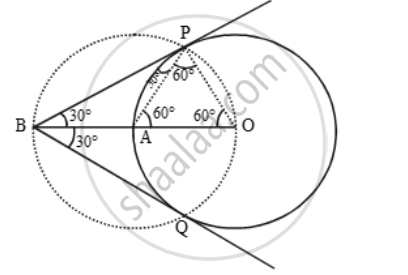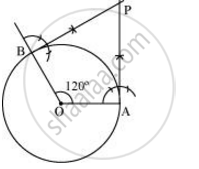Advertisements
Advertisements
प्रश्न
Draw a pair of tangents to a circle of radius 5 cm which are inclined to each other an angle of 60º.
उत्तर १
In order to draw the pair of tangents, we follow the following steps.

Step I: Take a point O on the plane of the paper and draw a circle of radius OA = 5 cm.
Step II: Produce OA to B such that OA = AB = 5 cm.
Step III: Taking A as the centre draw a circle of radius AO = AB = 5 cm.
Suppose it cuts the circle drawn in step I at P and Q.
Step IV: Join BP and BQ to get the desired tangents.
Justification: In OAP, we have
OA = OP = 5 cm (= Radius) Also,
AP = 5 cm (= Radius of circle with centre A)
∴ ∆OAP is equilateral.
⇒ ∠PAO = 60º ⇒ ∠BAP = 120º
In ∆BAP, we have
BA = AP and ∠BAP = 120º
∴ ∠ABP = ∠APB = 30º ⇒ ∠PBQ = 60º
उत्तर २
The tangents can be constructed in the following manner:
Step 1
Draw a circle of radius 5 cm and with centre as O.
Step 2
Take a point A on the circumference of the circle and join OA. Draw a perpendicular to OA at point A.
Step 3
Draw a radius OB, making an angle of 120° (180° − 60°) with OA.
Step 4
Draw a perpendicular to OB at point B. Let both the perpendiculars intersect at point P. PA and PB are the required tangents at an angle of 60°.

Justification
The construction can be justified by proving that ∠APB = 60°
By our construction
∠OAP = 90°
∠OBP = 90°
And ∠AOB = 120°
We know that the sum of all interior angles of a quadrilateral = 360°
∠OAP + ∠AOB + ∠OBP + ∠APB = 360°
90° + 120° + 90° + ∠APB = 360°
∠APB = 60°
This justifies the construction.
संबंधित प्रश्न
Draw a circle of radius 3 cm. Take two points P and Q on one of its extended diameter each at a distance of 7 cm from its centre. Draw tangents to the circle from these two points P and Q. Give the justification of the construction.
In the figure given below, diameter AB and chord CD of a circle meet at P. PT is a tangent to the circle at T. CD = 7.8 cm, PD = 5 cm, PB = 4 cm. Find:
1) AB.
2) the length of tangent PT.

Draw a circle of radius 3 cm. Mark a point P at a distance of 5 cm from the centre of the circle drawn. Draw two tangents PA and PB to the given circle and measure the length of each tangent.
Using ruler and compasses only, draw an equilateral triangle of side 4.5 cm and draw its circumscribed circle. Measure the radius of the circle.
Draw a circle of radius 3.5 cm. Mark a point P outside the circle at a distance of 6 cm from the centre. Construct two tangents from P to the given circle. Measure and write down the length of one tangent.
Draw a circle of radius 3.5 cm. Take two points A and B on one of its extended diameter, each at a distance of 5 cm from its center. Draw tangents to the circle from each of these points A and B.
Draw a circle with the help of a bangle. Take any point P outside the circle. Construct the pair of tangents form the point P to the circle
A park is of the shape of a circle of diameter 7 m. It is surrounded by a path of width of 0·7 m. Find the expenditure of cementing the path, if its cost is Rs 110 per sq. m ?
Draw a circle with centre O and radius 2.5 cm. Take a point P at a distance of 6 cm from the centre. Using ruler and compasses only construct the tangents to the circle from the point P.
Draw two circles of radii 3.5 cm and 2 cm respectively so that their centres are 6 cm apart. Draw direct common tangents to the circle and show that they are equal in length.
